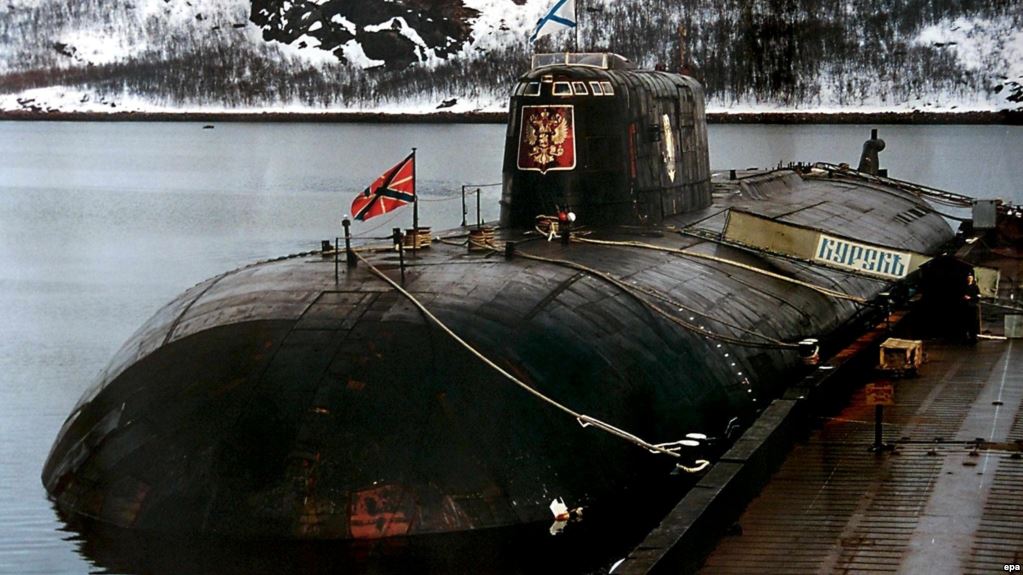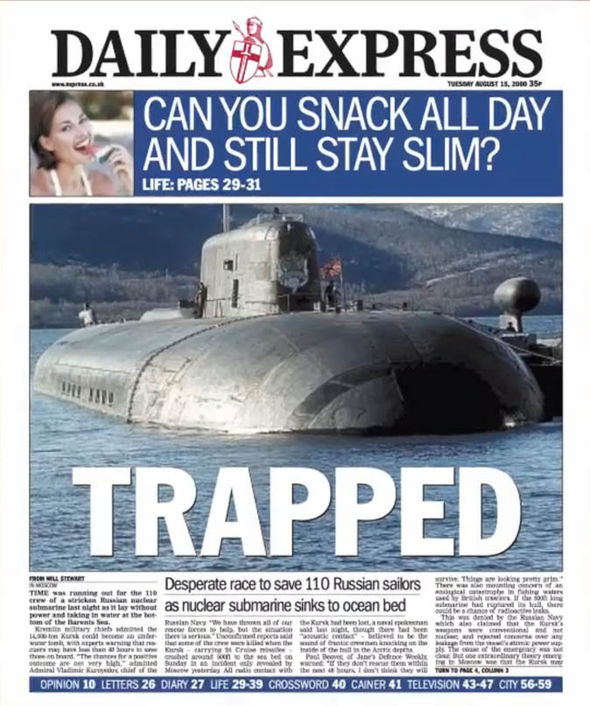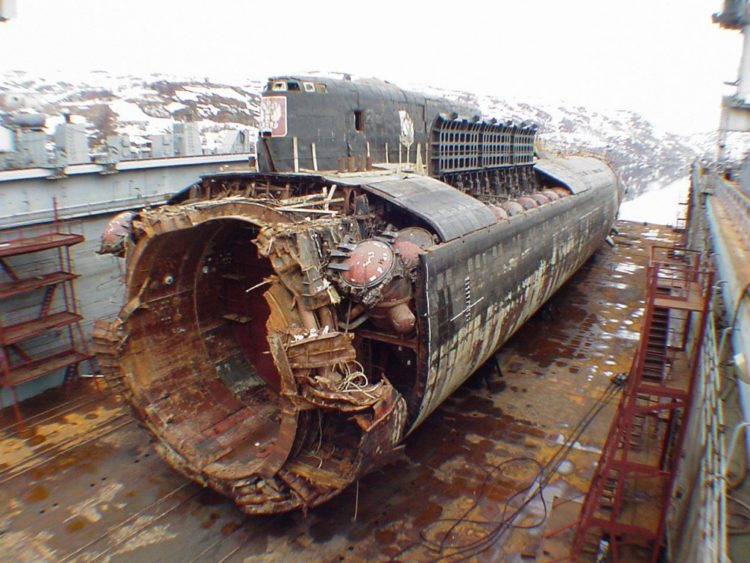
The film Kursk follows the 2000 K-141 Kursk submarine disaster and the governmental negligence that followed. As the sailors fight for survival, their families desperately battle political obstacles and impossible odds to save them. After an investigation determines that the sub was sunk by a U.S. torpedo, Cold War tensions are resurrected in a cat and mouse espionage battle.
Director: Thomas Vinterberg, Writer: Robert Rodat (screenplay), Stars: Léa Seydoux, Colin Firth, Matthias Schoenaerts
K141 Kursk (full Russian name Атомная Подводная Лодка «Курск» (АПЛ «Курск»), Atomnaya Podvodnaya Lodka “Kursk” (APL “Kursk”), meaning “Nuclear-powered submarine Kursk“) was an Oscar-II class nuclear-powered cruise-missile submarine of the Russian Navy which was lost with all hands when it sank in the Barents Sea on 12 August 2000. It was a Project 949A Антей (Antey, Antaeus; NATO reporting name “Oscar II”) submarine.
It was named after the Russian city of Kursk, around which the Battle of Kursk took place in 1943. One of the first vessels completed after the end of the Soviet Union, it was commissioned into the Russian Navy‘s Northern Fleet.
[amazon_link asins=’006093641X,B01NCKMFXY,0609610007,0996469508,B000PRBVCY,0446610720,190398548X,1840029366′ template=’ProductCarousel’ store=’spoup-20′ marketplace=’US’ link_id=’192ae470-75f8-11e7-be95-fdc76336fe2a’]
From a 2000 NY Times article: Trapped in the rear of a breached and sunken submarine on the Arctic seabed, the electricity failing, facing all-but-certain death with 22 companions, Lt. Capt. Dimitri Kolesnikov, the commander of the turbine room on the Russian submarine Kursk, scrawled a message 10 weeks ago to what was then an unknowing outside world.
”13:15,” he wrote, noting the military time. ”All personnel from compartments six, seven and eight moved to the ninth. There are 23 of us here. We have made this decision as a result of the accident. None of us can get out.”
Today, the world finally heard Captain Kolesnikov’s message after Russian divers recovered his remains from the husk of the submarine, and the note was found stuffed in his pocket.
The revelation that 23 of the Kursk’s 118 crewmen survived the sinking, at least for a while, set off a sensation and demolished assurances by senior military officials that the Kursk’s entire crew most likely had perished within minutes of the accident. And it instantly reignited a national debate over whether the military’s attempt to rescue the sailors, widely denounced as botched, was fatally flawed as well.
It also raised the prospect that divers would find more notes — perhaps containing evidence as to why the submarine exploded and sank — when and if bodies of other survivors are recovered.
It was the head of the Russian Navy’s northern fleet, Vice Adm. Mikhail Motsak, who described the note from Captain Kolesnikov, 27, whose rank would be comparable to a lieutenant in the American Navy. The captain was one of four sailors whose bodies have been retrieved since recovery operations began on Saturday.
Admiral Motsak refused to release the entire message, which he said contained a ”very private” farewell message to the captain’s family. But the excerpt printed by the semiofficial Itar-Tass news agency, with its reference to 23 survivors, offered a gripping, if brief, glimpse of the situation aboard the doomed vessel as it lay more than 300 feet below the ocean surface.
At a candle-lighting ceremony today in Vidyayevo, the seaside village where most of the Kursk crew lived and raised families, Adm. Vladimir Kuroyedov, the commander of the Russian Navy, said the captain’s message began legibly, as if written in a lighted room. But by its end, he said, it was a nearly illegible scrawl written, the note indicated, ”by feel.” Admiral Motsak said the note also indicated that two or three crewmen tried to flee the submarine through a specially built escape hatch in the ninth compartment, where the survivors were gathered. Russian submarines are equipped with suits designed to protect sailors during such underwater escapes.
”As we know, that attempt failed,” he said, ”maybe because it was filled with water.”
Norwegian divers who opened that escape hatch nine days after the disaster found that the air lock was filled with water. That led the navy to abandon all efforts to find anyone alive, and to turn its attention to recovering the dead. But the ninth compartment might have remained dry for weeks, even up until rescuers entered it.
Today’s revelation– and others, perhaps yet to come — may pump new energy into what is already a national catharsis.
More than simply a shared tragedy, the Kursk disaster psychologically staggered many here who seemed to feel that Russia’s last bragging rights — to technological excellence, to military competence, to first-tier global status — went down with the biggest and most fearsome boat in its submarine arsenal.
The accident quickly generated a public excoriation of the Kremlin, President Vladimir V. Putin and the military, followed by a backlash against the West. Military leaders insist with growing conviction that the Kursk was sunk by a collision with a Western submarine and not, as some experts speculate, by flaws in a new Russian torpedo propulsion system. This week, the recovery of the sailors’ bodies has dominated television news, with dramatic video from the sea floor and long lists of hot lines where relatives and the curious can keep up with the latest discoveries.
Today’s bombshell seemed certain to reopen still-fresh wounds, starting with the question of whether the navy could have rescued those entombed in the sunken submarine in the hours after it sank.
By American accounts, the Kursk revved its turbines after the first blast, apparently trying to reach the surface, then plunged to the seabed after the second. Admiral Motsak said Captain Kolesnikov had written his message between 1:34 p.m. and 3:15 p.m. that day. That suggested that at a minimum, he and 22 other crewmen survived nearly four hours after the explosions.
There was no explanation of why Itar-Tass’s version of the note stated that it was written at 1:15 p.m., while Admiral Motsak said it was begun at 1:34 p.m.
Captain Kolesnikov’s message suggests that nearly everyone in the aft portion of the submarine initially survived the explosions, which devastated the two fore compartments that housed torpedoes and the submarine’s command post. The Kursk’s published crew roster states that 24 sailors were assigned to compartments six through nine, one more than the 23 cited in his note.
What the note does not conclusively state — apparently — is how long those 23 survived, a fact crucial to any review of the navy’s rescue efforts.
By official accounts, the navy did not locate the Kursk, 354 feet below the Barents Sea surface, until nearly 16 hours after the accident, and did not lower the first rescue vessel until more than 15 hours after that.
A day later, the United States and Britain publicly offered to help in the Kursk rescue effort, but two more days passed before Mr. Putin ordered naval officials to accept any aid that was extended. And three more days went by before British and Norwegian rescue vessels arrived at the wreck site.
On Moscow streets this evening, Russians greeted the disclosure of the note with studied cynicism. ”I expected this. I think they took too long. They should have saved them,” said a 46-year-old civil servant who would be identified only as Galina. ”But who can you blame? Everything in our country has already collapsed.”
Viktor Olyasov, 55, declined to blame the military, saying nobody still knows whether a rescue was possible. ”I know only that if not for perestroika, if not for everyone going into business and thinking only of moving ahead, things like this wouldn’t happen,” he said.
And the captain’s widow, Olga Kolesnikova, her face covered with tears, said her husband had a premonition of death before leaving on the Kursk’s last voyage and left his dog tags, a crucifix and a poem as a remembrance.
The couple had married only this year.
”And when the time comes to die,” he wrote in the poem, ”though I chase such thoughts away, I want time to whisper one thing: My darling, I love you.”
https://youtu.be/vihv_cQBawo



